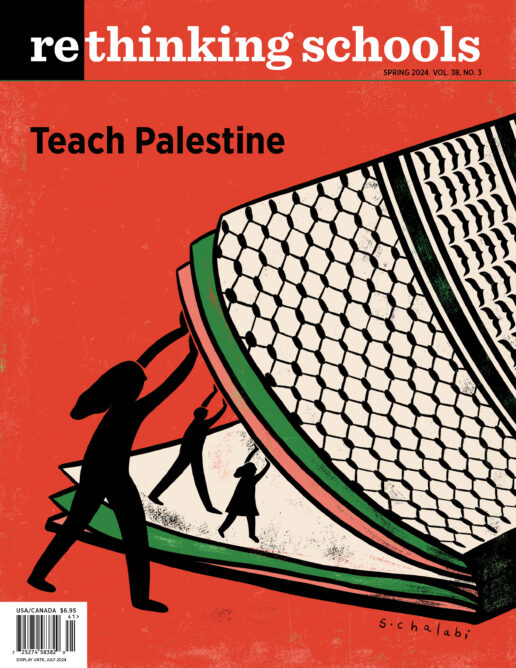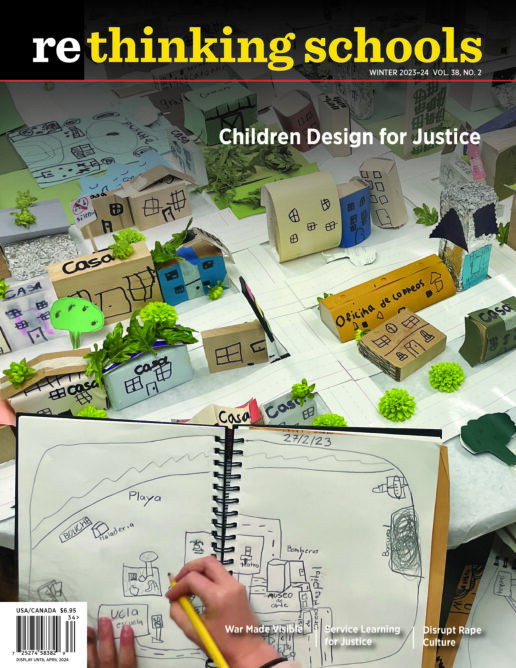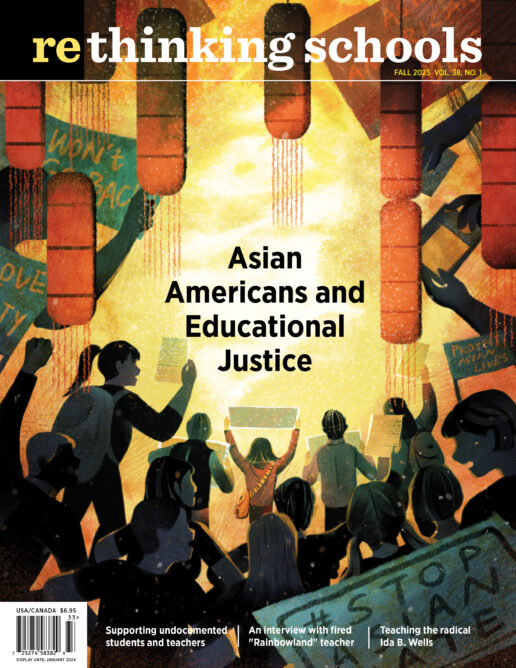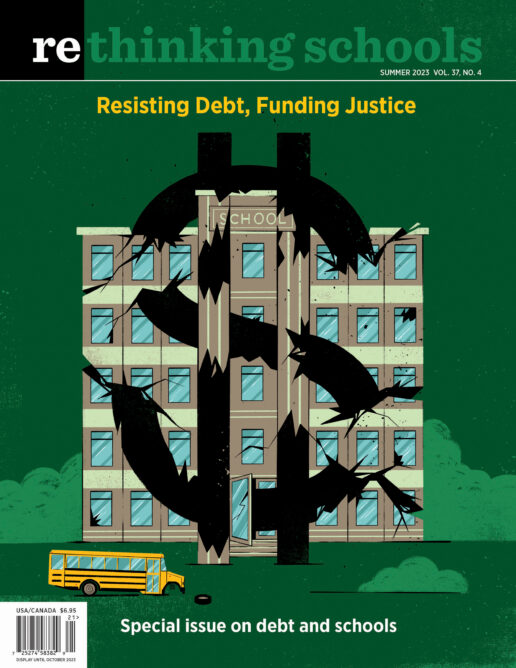-
#SchoolsToo: Educators’ Responsibility to Confront Sexual Violence
The ongoing, persistent verbal and physical violence against women, youth, and LGBTQ communities has not been adequately addressed in most schools. Instead of educating children and youth about gender equity and sexual harassment, schools often create a culture that perpetuates stigma, shame, and silence. Student-on-student sexual assault and harassment occurs on playgrounds, in bathrooms and locker rooms, on buses, and down isolated school hallways. Students experience sexualized language and inappropriate touching, as well as forced sexual acts. And they encounter these at formative stages of their lives that leave scars and shape expectations for a lifetime. What isn’t addressed critically in schools becomes normalized and taken for granted.
-
What Students Are Capable Of
Sexual Harassment and the Collateral Beauty of Resistance
“We have something to tell you but we’re worried about getting you too involved. We don’t want to get you in trouble,” Baylee and Zaida whispered excitedly as they wiggled through the crack in my classroom door on my prep. I was confused to see them in such high spirits because earlier in the day they had been crushed by news from our administration. For more than two months they had been part of our Restorative Justice club that had been planning two half-day workshops around women empowerment for female-identifying students and toxic masculinity for male-identifying students. The club of 11 demographically diverse students had been urging adults in our building to do something about sexual harassment since October, when they made sexual assault and harassment their Restorative Justice club theme of the month and visited 9th grade classes to lead circles on the topic. This opened up a door for 9th graders to continue to reach out to upperclassmen about the harassment they were facing.
-
#MeToo and The Color Purple
During a recent conversation, a former high school classmate said, “I always wondered why you left Eureka. I heard that something shameful happened, but I never knew what it was.”
Yes, something shameful happened. My former husband beat me in front of the Catholic Church in downtown Eureka. He tore hunks of hair from my scalp, broke my nose, and battered my body. It wasn’t the first time during the nine months of our marriage. When he fell into a drunken sleep, I found the keys he used to keep me locked inside and I fled, wearing a bikini and a bloodied white fisherman’s sweater. For those nine months I had lived in fear of his hands, of drives into the country where he might kill me and bury my body. I lived in fear that if I fled, he might harm my mother or my sister.
I carried that fear and shame around for years. Because even though I left the marriage and the abuse, people said things like “I’d never let some man beat me.” There was no way to tell them the whole story: How growing up and “getting a man” was the goal, how making a marriage work was my responsibility, how failure was a stigma I couldn’t bear.
-
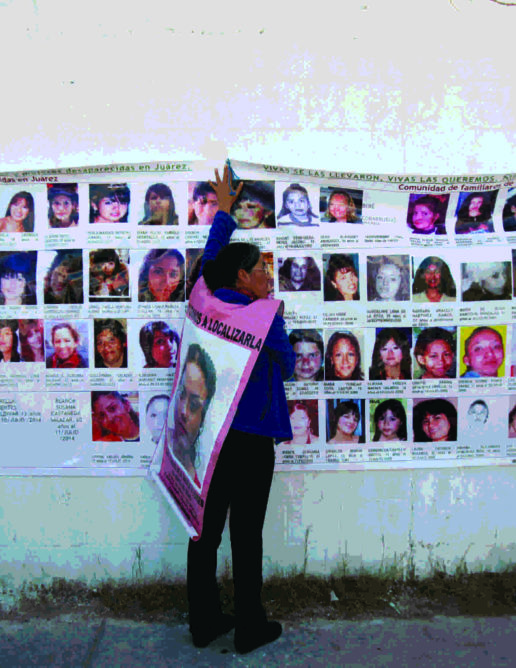
“Young Women Like Me”
Teaching About Femicides and Reckless Capitalism on the Mexican Border
Since 1993, the Mexican border city of Ciudad Juárez has been shaken by disappearances of teenage girls and young women. Officials say they have few leads. The murders in Juárez have received some international attention, primarily due to government inaction. Yet little has been done by the government to prevent violence against women and girls, as officials neglect to bring their perpetrators to justice.
Residents do not let these deaths go unnoticed as hundreds of pink crosses — a symbol of these missing women — dot the border. An increase in these deaths coincided with the implementation of the North American Free Trade Agreement (NAFTA). A treaty between Mexico, the United States, and Canada, NAFTA sought to increase investment opportunities by eliminating tariffs and, like many other economic agreements, benefited the economic elites of the three countries while resulting in widespread unemployment, increased class stratification, and mass emigration. Most of the “disappeared” women work in assembly plants or maquiladoras, owned by the United States and transnational corporations that dashed to northern Mexico post-NAFTA to reap the benefits of lower wages and lax environmental regulation.
-
The Women of Juárez
at the West tip of Texas
a line divides us from them
and on the other side
they all look like me
yet on my side we sit passively nearby
while the other side allows a slow genocide -
“I Believe You”
Responsive Teacher Talk and Our Children’s Lives
To all of my students: I believe you.
Every Monday morning Lilly would walk into our 1st-grade classroom with downcast eyes and a heavy heart. She would wait for everyone to settle in and then quietly beckon me over to her seat and say, “My head hurts.”
It became a routine. I would stroke her head and say, “I know you miss your dad. Let’s try participating in school and see if it helps you feel better.” This seems like a reasonable response from a seasoned veteran teacher in her 31st year of teaching. My message to Lilly was I understand children, I understand your life, and I know what is best for you.
-
“How Could You Let This Happen?”
Dealing with 2nd Graders and Rape Culture
I was just about to finish my second year teaching 2nd grade. It was the first week of June and school was quickly coming to a close. The sun was out and everyone’s energy was extraordinarily high. We were in Seattle after all; when the sun comes around, you rejoice. One morning that week I came to work and noticed I had an email from a parent. This was a parent I had a good relationship with, and she often checked in to see how her daughter was doing. But this email was different. The mother explained that her daughter had been cornered at recess the previous day by some boys who were also 2nd graders. The boys grabbed, groped, and humped her. They told her they were going to have sex with her. Her daughter told them to stop and to leave her alone, but they persisted. As this sweet one told her story of shame, confusion, and hurt to her family later that day, she became so upset that she threw up in the car. Her mother knew this wasn’t a miscommunication or misunderstanding.
-
In Philadelphia, Teacher Book Groups Are the Engines of Change
One Mom’s Reflection
On a chilly day in the late fall of 2015, in the pews of the Old First Reformed United Church of Christ in the Old City Neighborhood of Philadelphia near the Delaware River, we sat, excited with anticipation, among nearly 200 participants at the second annual Philadelphia Caucus of Working Educators (WE) daylong convention. The nine members of our slate who would challenge existing union leadership in the upcoming election had just been announced and Ismael Jimenez, the nominee for vice president of high schools, took the mic:
We need to start shifting this paradigm. This paradigm that has us disengaged. Powerless. Beholden to interests that aren’t ours. They are treating us like objects. Things just happen to us. No longer can we sit in complacency. The victory that I’m talking about isn’t just a PFT [Philadelphia Federation of Teachers] election. This is a means to an end. And the end is justice. -
Black Boys in White Spaces
One Mom’s Reflection
Right away I recognized her. Ruby Bridges. The courageous girl who defied white racists and became the first to integrate an all-white elementary school. My 7-year-old son pulled a handout out of his backpack with her face on it. He is in a bilingual, two-way immersion program at our local elementary school. As is our custom on Friday, we emptied his backpack and sorted the contents. We determined what needed to be recycled, what would be hung on our whiteboard, and what needed to be stored in my Things-to-take-care-of box by the fridge. I smiled, because as a former history teacher and lover of Black history, I was happy to see my son learning about this important historical moment. And then, I took a closer look and saw that it was in Spanish. I was elated as it dawned on me that my son truly is emergent bilingual. “Caleb, what’s this about? Did you read this in school?”
-
Beyond the Travel Ban
Refugee Educational Prospects in the Era of Trump
In May 2016, while I was carrying out ethnographic research in the Kakuma Refugee Camp in Kenya, a Form 4 (12th grade) history teacher asked me if I would teach his students about U.S. democracy. We flipped through the history and government textbook to one of the last chapters where the national curriculum outlined political systems in Kenya, England, India, and the United States. It was a peculiar moment to put the U.S. democratic system on display.
-
Ignoring Diversity, Undermining Equity
NCTQ and Elementary Literacy Instruction
NCTQ, which claims to “provide an alternative national voice to existing teacher organizations and to build the case for a comprehensive reform agenda that would challenge the current structure and regulation of the profession,” was created by the Thomas B. Fordham Foundation in 2000 and incorporated in 2001 as a policy response to a perception that colleges of education were not adequately preparing teachers. According to education historian and NCTQ critic Diane Ravitch, the conservative members of the Thomas B. Fordham foundation perceived teacher training as problematic due to an overemphasis on social justice and a lack of focus on basic academic skills and abilities. Thus, NCTQ was originally founded as an entity through which to encourage alternative certification and circumvent colleges of education. Indeed, early on, NCTQ was closely connected to ABCTE (American Board for the Certification of Teacher Excellence), which created a series of tests that potential teachers could pass in order to bypass teacher education programs altogether by paying $1,995.00.
-
The Teacher Uprising of 2018
They’re calling it the “Education Spring,” and what started in a rural county in southwest West Virginia has spread like wildfire and inspired teachers and other public sector workers across […]
-
Climate Change, Gender, and Nuclear Bombs
Column: Earth, Justice, and Our Classrooms
In the spring 2011 issue of Rethinking Schools we editorialized about the immense gulf between our terrible environmental crisis — especially the climate crisis — and the adequacy of schools’ curricular response. Seven years later, we still see this gap between crisis and curriculum — which is why we are launching this regular “Earth, Justice, and Our Classrooms” column: to offer encouragement and resources for teachers to help students explore the roots and consequences of the crisis and figure out how to respond.
-

Our picks for books, videos, websites, and other social justice education resources 32.3
Check out these valuable resources, reviewed by Rethinking Schools editors and Teaching for Change colleagues.
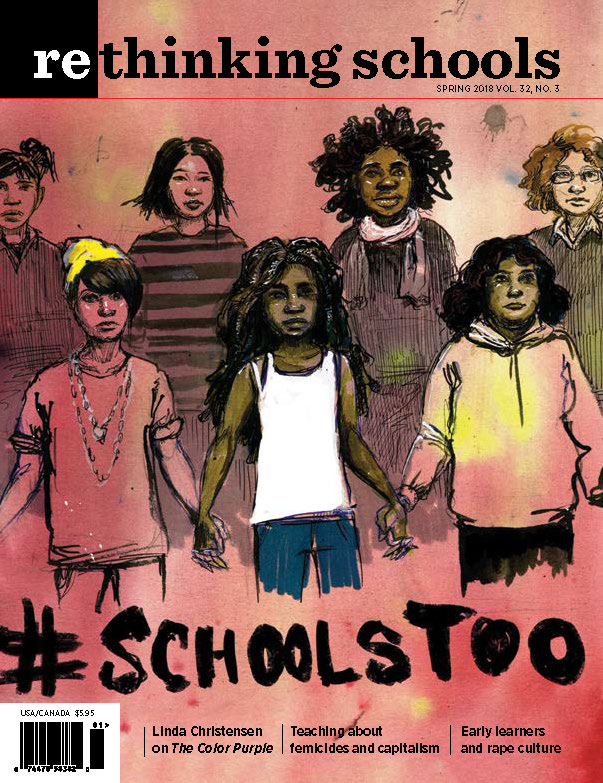
Volume 32, No. 3
Spring 2018
The spring issue of Rethinking Schools, which features all female writers and all female illustrators, mostly focuses on the intersection of the #MeToo movement and K–12 schools. It has articles about how students were able to draw on curricular lessons to fuel activism surrounding sexual harassment, about the importance of teaching books like The Color Purple and the role of literature in combating patriarchy, about femicides in Juárez and the relationship between global capitalism and feminism, and about dealing with rape culture in and outside the classroom, among many others. In addition to the #MeToo coverage, there is also a special article by Dyan Watson called “Black Boys in White Spaces” that is about the toxicity of learning environments that devalue Black lives as well as a special article about book groups in Philadelphia that have become an engine for progressive change.
Annual Subscription: $24.95
Purchase Digital Copy: $4.95
To purchase individual paper copies of the magazine email us or call customer service at 1-800-669-4192

